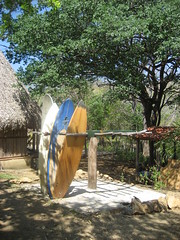One of my favorite ways to eat more greens is to use them in place of bread or crackers. Nothing against burger buns or sandwich bread but you can skip the processed wheat and grab a bunch of crispy Romaine or collard greens instead. I use Romaine lettuce like a taco shell- fill it up with whatever you like- sliced avocado, tomato, homemade mayo and bacon for a healthier B.L.T. Bibb lettuce is soft, flexible and makes for a great little wrap. Want to eat that salad with your hands? Wrap it up in the biggest lettuce leaves from the outside of the bunch. Look at you, doubling down on your veggies!
Using large collard leaves makes for a sturdier wrap that can hold such awesome summer foods as cheese burgers or the ultimate sunny seed hummus wrap. You can use the leaves raw or lightly steamed — these are best for hot foods or for bigger wraps. The folding is easy and unlike regular wraps, these stay sealed. The only prep work you need to do is to carefully trim them rough stems.
Cut the end of the stem off and then lay the collard leaf flat and slice off the rough stem that sticks up, so that the leaf is flat and entirely flexible, like in this photo from MindBodyGreen.com’s tutorial on how to use collards like a wrap!
Don’t worry if you tear the collard leaf a bit, you’ll get the hang of the stem trimming and can fold around any small tear.
If you want to steam your collard leaves so that they are more flexible and easier to use and eat, there are a few methods that work well. This video from Plant Powered Kitchen.com has my favorite technique for when you just want to make up a few wraps. Get some water boiling in your kettle and open the spout so you’ve got a nice stream of steam coming up. Hold your raw collard leaf by the stem and wave it over the spout of steam, lightly steaming the whole leaf until it’s bight green and soft enough to fold. Then trim off the stem as described above. Repeat until you have enough wraps.
Or, follow the quick blanch method I found on Mind Body Green.com– bring a wide shallow pan of water to a simmer. Take your de-stemmed collard leaves and give them a 10 second dunk in the pan, one at a time, using tongs to get the collard leaves in and then out and into an ice bath. Dry in layers using tea towels. Once you’ve got all your wraps ready, fill as desired!
The wrapping part is easy, and there are a number of ways to do it, but this photo tutorial from Honest Fare.com is easy to follow:
Add your filling to the center of one or two overlapping leaves. Fold the sides in to contain the filling. Then, starting at one long end, roll the leaf over the filling and keep rolling, making sure the ends stay tucked in. Slice in half and enjoy!
 Above, a collard wrapped Bareburger – it’s as good as it looks!
Above, a collard wrapped Bareburger – it’s as good as it looks!










































